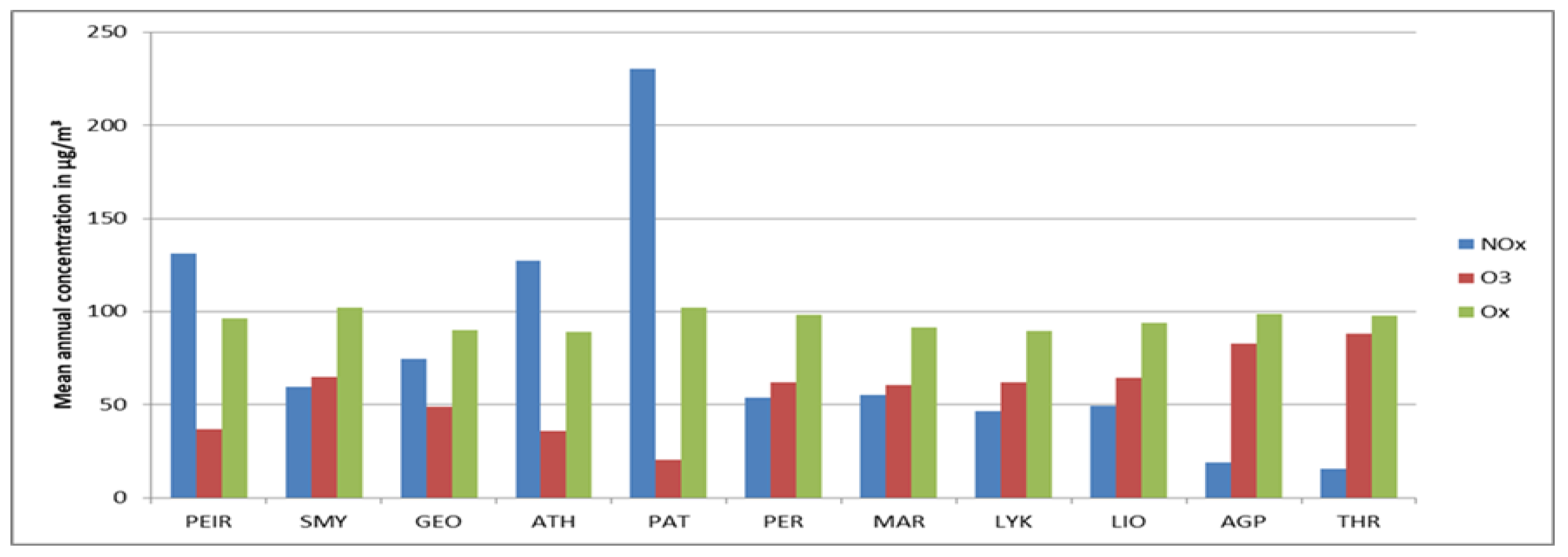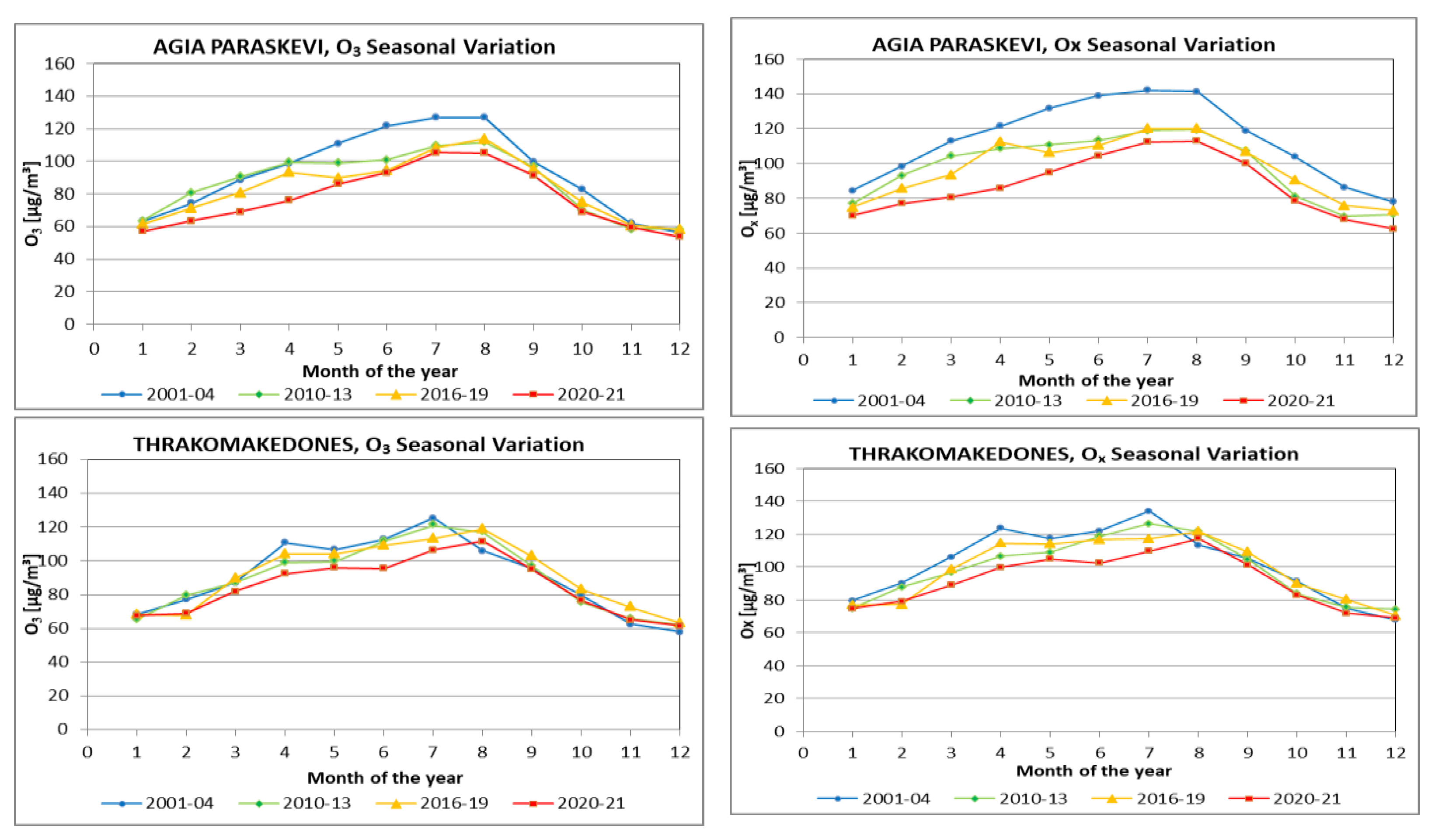The Evolution of the Seasonal Variation and the Summer Diurnal Variation of Primary and Secondary Photochemical Air Pollution in Athens †
Abstract
1. Introduction
2. Results and Discussion
3. Conclusions
Author Contributions
Funding
Institutional Review Board Statement
Informed Consent Statement
Data Availability Statement
Conflicts of Interest
References
- Mantis, H.T.; Repapis, C.C.; Zerefos, C.; Ziomas, I. Assessment of the potential for photochemical air pollution in Athens: A comparison of emissions and air-pollutant levels in Athens with those in Los Angeles. J. Appl. Meteor. 1992, 31, 1467–1476. [Google Scholar] [CrossRef]
- Ziomas, I.; Suppan, P.; Rappengluck, B.; Balis, D.; Tzoumaka, P.; Melas, D.; Papayannis, A.; Fabian, P.; Zerefos, C. A contribution to the study of the photochemical smog in the greater Athens area. Beit. Phys. Atmos. 1995, 68, 191–203. [Google Scholar]
- Rappenglück, B.; Fabian, P.; Kalabokas, P.; Viras, L.G.; Ziomas, I.C. Quasi-continuous measurements of non-methane hydrocarbons (NMHC) in the greater Athens area during MEDCAPHOT-TRACE. Atmos. Environ. 1998, 32, 2103–2121. [Google Scholar] [CrossRef]
- Ziomas, I.C. The mediterranean campaign of photochemical tracers-transport and chemical evolution (MEDCAPHOT-TRACE): An outline. Atmos. Environ. 1998, 32, 2045–2054. [Google Scholar] [CrossRef]
- Kalabokas, P.D.; Viras, L.G.; Repapis, C.C.; Bartzis, J.G. Analysis of the 11-year record (1987–1997) of air pollution measurements in Athens; Greece. Part II: Photochemical pollutants. Glob. Nest Int. J. 1999, 1, 169–176. [Google Scholar]
- Kalabokas, P.D.; Viras, L.G.; Repapis, C.C. Analysis of the 11-year record (1987–1997) of air pollution measurements in Athens; Greece. Part I: Primary air pollutants. Glob. Nest Int. J. 1999, 1, 157–168. [Google Scholar]
- Kalabokas, P.D.; Viras, L.G.; Bartzis, J.G.; Repapis, C.C. Mediterranean rural ozone characteristics around the urban area of Athens. Atmos. Environ. 2000, 34, 5199–5208. [Google Scholar] [CrossRef]
- Kalabokas, P.D.; Repapis, C.C. A climatological study of rural surface ozone in central Greece. Atmos. Chem. Phys. 2004, 4, 1139–1147. [Google Scholar] [CrossRef]
- Kalabokas, P.; Repapis, C.C.; Mantis, H. A field study on the origins of surface ozone at the periphery of the urban area of Athens. Fresenius Environ. Bull. 2006, 8, 878–882. [Google Scholar]
- Zerefos, C.S.; Kourtidis, K.A.; Melas, D.; Balis, D.; Zanis, P.; Katsaros, L.; Mantis, H.T.; Repapis, C.; Isaksen, I.; Calpini, B.; et al. Photo-chemical Activity and Solar Ultraviolet Radiation (PAUR) Modulation factors: An overview of the project. J. Geophys. Res. 2002, 107, 8134. [Google Scholar] [CrossRef]
- Kourtidis, K.; Zerefos, C.; Rapsomanikis, S.; Simeonov, V.; Balis, D.; Perros, P.E.; Thompson, A.M.; Witte, J.; Calpini, B.; Sharobiem, W.M.; et al. Regional levels of ozone in the troposphere over Eastern Mediterranean. J. Geophys. Res. 2002, 107, 8140. [Google Scholar] [CrossRef]
- Kalabokas, P.D.; Mihalopoulos, N.; Ellul, R.; Kleanthous, S.; Repapis, C.C. An investigation of the meteorological and photochemical factors influencing the background rural and marine surface ozone levels in the Central and Eastern Mediterranean. Atmos. Environ. 2008, 42, 7894–7906. [Google Scholar] [CrossRef]
- Poupkou, A.; Melas, D.; Ziomas, I.C.; Symeonidis, P.; Lisaridis, I.; Gerasopoulos, E.; Zerefos, C. Simulated summertime regional ground-level ozone concentrations over Greece. Water Air Soil. Pollut. 2009, 196, 169–181. [Google Scholar] [CrossRef]
- Mariolopoulos, E.; Zerefos, C.S.; Bloutsos, A.; Repapis, C. Ozone and temperature balloon measurements during the annular solar eclipse of 29 April 1976. Proc. Acad. Athens 1977, 51, 636–645. [Google Scholar]
- Varotsos, C.; Kalabokas, P.; Chronopoulos, G. Atmospheric ozone concentration at Athens, Greece. Part II: Vertical ozone distribution in the troposphere. Atmos. Res. 1993, 30, 151–155. [Google Scholar] [CrossRef]
- Kalabokas, P.D.; Chronopoulos, G.; Varotsos, C.; Zerefos, C.; Repapis, C.C. Vertical tropospheric ozone characteristics over Athens, Greece. In Proceedings of the XX Quadrennial Ozone Symposium, Kos, Greece, 1–8 June 2004; pp. 191–192. [Google Scholar]
- Papayannis, A.; Balis, D.; Zanis, P.; Galani, E.; Wernli, H.; Zerefos, C.; Stohl, A.; Eckhardt, S.; Amiridis, V. Sampling of an STT event over the Eastern Mediterranean region by lidar and electrochemical sonde. Ann. Geophys. 2005, 23, 2039–2050. [Google Scholar] [CrossRef][Green Version]
- Kalabokas, P.D.; Volz-Thomas, A.; Brioude, J.; Thouret, V.; Cammas, J.P.; Repapis, C.C. Vertical ozone measurements in the troposphere over the Eastern Mediterranean and comparison with Central Europe. Atmos. Chem. Phys. 2007, 7, 3783–3790. [Google Scholar] [CrossRef]
- Kalabokas, P.D.; Papayannis, A.D.; Tsaknakis, G.; Ziomas, I. Study on the atmospheric concentrations of primary and secondary air pollutants in the Athens basin performed by DOAS and DIAL measuring techniques. Sci. Total Environ. 2012, 414, 556–563. [Google Scholar] [CrossRef]
- Kalabokas, P.D.; Cammas, J.-P.; Thouret, V.; Volz-Thomas, A.; Boulanger, D.; Repapis, C.C. Examination of the atmospheric conditions associated with high and low summer ozone levels in the lower troposphere over the eastern Mediterranean. Atmos. Chem. Phys. 2013, 13, 10339–10352. [Google Scholar] [CrossRef]






Disclaimer/Publisher’s Note: The statements, opinions and data contained in all publications are solely those of the individual author(s) and contributor(s) and not of MDPI and/or the editor(s). MDPI and/or the editor(s) disclaim responsibility for any injury to people or property resulting from any ideas, methods, instructions or products referred to in the content. |
© 2023 by the authors. Licensee MDPI, Basel, Switzerland. This article is an open access article distributed under the terms and conditions of the Creative Commons Attribution (CC BY) license (https://creativecommons.org/licenses/by/4.0/).
Share and Cite
Kalabokas, P.; Stavraka, T.; Kapsomenakis, J.; Poupkou, A.; Zerefos, C. The Evolution of the Seasonal Variation and the Summer Diurnal Variation of Primary and Secondary Photochemical Air Pollution in Athens. Environ. Sci. Proc. 2023, 26, 122. https://doi.org/10.3390/environsciproc2023026122
Kalabokas P, Stavraka T, Kapsomenakis J, Poupkou A, Zerefos C. The Evolution of the Seasonal Variation and the Summer Diurnal Variation of Primary and Secondary Photochemical Air Pollution in Athens. Environmental Sciences Proceedings. 2023; 26(1):122. https://doi.org/10.3390/environsciproc2023026122
Chicago/Turabian StyleKalabokas, P., Th. Stavraka, J. Kapsomenakis, A. Poupkou, and C. Zerefos. 2023. "The Evolution of the Seasonal Variation and the Summer Diurnal Variation of Primary and Secondary Photochemical Air Pollution in Athens" Environmental Sciences Proceedings 26, no. 1: 122. https://doi.org/10.3390/environsciproc2023026122
APA StyleKalabokas, P., Stavraka, T., Kapsomenakis, J., Poupkou, A., & Zerefos, C. (2023). The Evolution of the Seasonal Variation and the Summer Diurnal Variation of Primary and Secondary Photochemical Air Pollution in Athens. Environmental Sciences Proceedings, 26(1), 122. https://doi.org/10.3390/environsciproc2023026122





